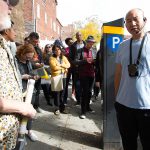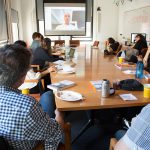On Monday November 6th, Gallatin’s Urban Democracy Lab (UDL) hosted Miriam Greenberg, Penny Lewis, and Daniel Aldana Cohen, contributors to the new book, The City is the Factory: New Solidarities and Spatial Strategies in an Urban Age. The conversation dived deeply into what would constitute a truly sustainable city. This panel honed in on the exciting prospects of progress that exist in the future of cities, focusing on the connection between urban longevity, labour rights and disaster relief response.
Continue reading “REVIEW: The City is the Factory Panel Discussion”
admin
Capital Sinks: Urban Eco-Resilience In the Face of Capitalist Power Structures
“What should cities of the future look like?”
This was one of the questions posed by Ashley Dawson, an author and member of a panel on Friday, November 3, 2017 panel, Urban Futures. The conversation, held at the CUNY graduate center, was sponsored by The Center for the Humanities. Kendra Sullivan, the associate director of The Center for the Humanities, kicked off the event by introducing the speakers. The panel also featured architect Catherine Seavitt, environmental activist Mychal Johnson, and urban theorist/author David Harvey. The discussion centered around the current and “extreme” state of cities, the progress that has or hasn’t been made since Hurricane Sandy, and what prospects for radical transformation lie in the cities of the future.
Continue reading “Capital Sinks: Urban Eco-Resilience In the Face of Capitalist Power Structures”
VIDEO: After-Effects of the High Line
Review: After-Effects of the High Line
“After-Effects of the High Line” was held on Oct. 24 in Cooper Square at NYU. Throughout the evening, urban scholars and social theorists engaged with questions of hyper-gentrification surrounding one of New York City’s most modern landmarks. The self-moderated panel discussion featured brief presentations by the University of Oregon’s Christoph Lindner, Queens College/CUNY Graduate Center’s Brian Rosa and Queensborough Community College’s Julia Rothenberg before fielding audience questions and debate. Each offered invigorating insight into qualities of a place often perceived simply, as a pleasant public good.
Lindner opened the evening by noting that the public and academic response to the High Line has been generally celebratory. From tourist site ratings to environmental and economic development groups, the High Line has been lauded as an exceptional example of infrastructural reuse. However, Lindner and Rosa’s co-edited book, Deconstructing the High Line: Postindustrial Urbanism and the Rise of the Elevated Park, encourages a more critical engagement with the space. The Tuesday evening event, Lindner said, was about “bringing together a group of people to be difficult about the High Line.”
Continue reading “Review: After-Effects of the High Line”
After/Life Tells Untold Stories of the ’67 Detroit Rebellion
From friend of the UDL, Kristin Horton:
After/Life is a new play about the ’67 Detroit rebellion that braids together oral histories with archival materials, poetry, song, and dance, and is the first theatrical accounting of the rebellion told with a focus on the experiences of women and girls. Lisa Biggs developed and produced the script in Detroit, Michigan, under the direction of Kristin Horton, Associate Professor of Theatre Practice at New York University’s Gallatin School of Individualized Study. After/Life was performed the last two weeks of July 2017 in conjunction with several community commemoration events that marked the fiftieth anniversary of the rebellion. Here Biggs and Horton discuss how the decision to offer the piece as a site for community commemoration shaped the content and aesthetic choices of the production.
Kristin Horton: Lisa, how did After/Life begin?
Lisa Biggs: When I moved to Michigan in 2013 from Chicago, Illinois, I knew very little Michigan history. That fall, stories about the collapse of the auto industry, police brutality, mortgage crisis and water shut offs, the emergency management situation, the poor conditions of the roads and schools across the state dominated the news. Michiganders around me specifically identified the issues of police brutality, workplace and housing discrimination, and nonresponsive elected officials as contributing factors to the historic and contemporary conditions….
Read the full interview here.
Photos: The Big Walk 2017
Review: Peter Moskowitz discusses How to Kill a City
What is perhaps most remarkable about Peter Moskowitz’s book, How to Kill a City: Gentrification, Inequality, and the Fight for the Neighborhood is its accessibility and simplicity. Moskowitz joined the Urban Democracy Lab for a discussion on October 4, 2017. He presented on his new book, answered questions, and led a discussion on gentrification and housing justice movements.
Gentrification is a notoriously nebulous, complicated, and heated topic that is difficult to define and link historically. It is also something that is necessarily defined in terms of place, because it is so specific to the space that it is occurring in, and yet it is universal and follows similar patterns in many cities across the United States and the world. It is also, as Moskowitz shows clearly, a violent act, predicated on systems of oppression and colonization that have persisted for centuries. As Moskowitz says with regards to New York City, his hometown, “It became clear that for most poor New Yorkers, gentrification wasn’t about some ethereal change in neighborhood character. It was about mass evictions, about violence, about the decimation of decades-old cultures” (4).
Continue reading “Review: Peter Moskowitz discusses How to Kill a City”
Photos: Book Talk with Peter Moskowitz
Review: Michael Hardt speaks on Assembly
How can social movements succeed without centralized leadership? Michael Hardt tackles this question in his recent book Assembly, co-authored with Italian intellectual Antonio Negri. The Urban Democracy Lab co-sponsored a discussion of Assembly with Hardt on September 25, 2017. Hardt, best known for his trilogy of influential books co-written with Negri—Empire, Multitude, and Commonwealth—is a key thinker in political left.
Continue reading “Review: Michael Hardt speaks on Assembly”
Why Your Mortgage Interest Deduction Might Be Bad Housing Policy
The home mortgage interest deduction is the largest federal housing subsidy in the United States. It is also, as the sociologist Matthew Desmond wrote in the New York Times Magazine, “what may very well be the most regressive piece of social policy in America.” Because this policy is an income tax deduction, it is most valuable to people in the highest income brackets—and in particular, to those who borrowed the most money in order to buy the very most expensive homes. That is an unusual way for a government to encourage the provision of housing.
How did we end up with this peculiar social policy? Who benefits from it? And why, given its apparent disadvantages, does it persist?
The Mortgage Tax Reform Working Group met on July 15, 2017 at the Urban Democracy Lab to discuss several new research projects in progress on these questions. Three research presentations guided the discussion. The authors, titles, and abstracts of these presentations were as follows:
Joshua McCabe, “The Road Not Taken: The Politics of Mortgage Tax Relief in the U.S. and U.K.”
Abstract:
Both the U.S. and the U.K. introduced tax deductions for (mortgage) interest paid as part of their original income tax legislation. Whereas the home mortgage interest deduction (HMID) has come to be seen as an untouchable “third rail” in American politics, the British government quietly eliminated mortgage interest relief (MIR) in 2000. This paper traces the divergence in outcomes to the 1970s with an emphasis on the interaction between institutions and policy sequence. The 1974 decision of British policymakers to place a nominal cap on MIR led to substantial erosion in the inflationary decade that followed. This weakened political support, allowing successive governments to actively reduce and eliminate it between 1991 and 2000. The structure of American political institutions prevented policymakers from successfully placing a nominal cap on HMID until 1987, at which point inflation was back under control. As a result, the political cost of directly attacking HMID remains strong until this day.
Monica Prasad, “The Problem of the Wellesley Democrat.”
Abstract:
Contrary to popular perception, it is not impossible to reform the Home Mortgage Interest Deduction (HMID). Congress has done so on at least two occasions. The first section of this paper briefly discusses these two episodes in the context of several failed attempts to reform the HMID over the last half-century. One conclusion from this overview is that Democrats have in fact been able to reform the HMID when they have chosen to try. The second section then considers why Democrats may not be particularly interested in HMID reform today, asking whether this is because—as some commentators have speculated–demographic and partisan changes have led to a situation in which HMID reform would affect Democratic constituencies more than Republican ones. Wellesley, Massachusetts, is an example of the kind of constituency that traditionally supports Democrats, but would be hardest hit by HMID reform. We use polling data and state and county-level analysis of election results to answer this question, but reach conflicting results: there is indeed a strong negative correlation between housing prices and Republican voting, at both state and county level. But polls do not show income having an effect on respondents’ attitudes to HMID.
Isaac William Martin, “How Inegalitarian is the Home Mortgage Interest Deduction?”
Abstract:
Sociologists have described the HMID as a regressive subsidy for the rich, and have argued that it exacerbates economic inequality, especially inequality between black and white Americans. But just how much does the HMID contribute to inequality in America? This project presents new evidence about the incidence of the HMID from an analysis of the Panel Study of Income Dynamics that takes economic sociology seriously, by modeling alternative tax-and-transfer distributions that might be possible on the assumptions that housing markets are embedded in regulatory institutions, potentially characterized by path-dependent development, and segmented by status. I argue for a sociological approach to incidence analysis that involves comparisons among multiple counterfactual scenarios, judged on the grounds of their sociological tenability. By setting logical bounds on the parameter values considered in these scenarios, it is possible to show that the aggregate distributional effects of the HMID approach the maximally inegalitarian extreme, in the sense that almost any other way of distributing the equivalent tax revenues would reduce the inequality of disposable income. It is also possible to estimate bounds on the inequality-reducing effects of eliminating the HMID. In the simulations presented here, the effect of eliminating the HMID is shown to be, at most, a 4% reduction in selected measures of aggregate income inequality. Eliminating the HMID in favor of some more egalitarian tax and transfer policy of equivalent budgetary magnitude is not the largest egalitarian policy intervention that might be contemplated, but it is also not trivial.
In addition to discussing these three research projects, the Mortgage Tax Reform Working Group discussed the possible implications of these preliminary findings, debated other research priorities, and engaged in preliminary planning for a panel discussion of the comparative historical sociology of the HMID that will take place at the annual meetings of the Social Science History Association in Montreal, November 2-5, 2017.




















